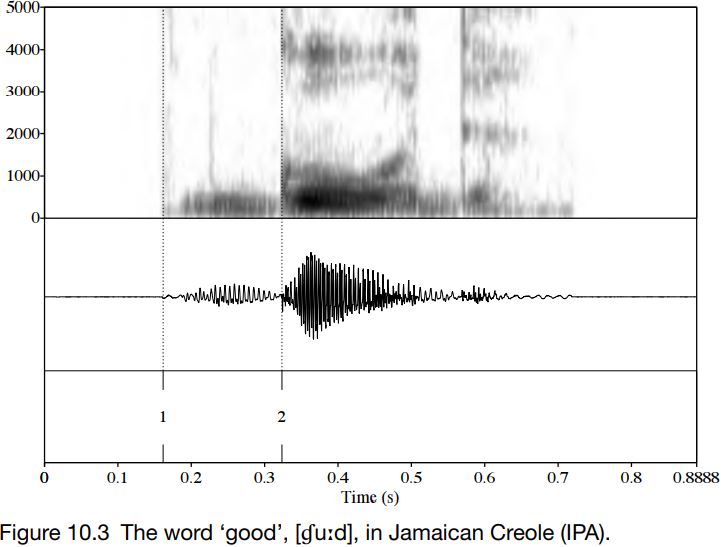


 Grammar
Grammar
 Tenses
Tenses
 Present
Present
 Past
Past
 Future
Future
 Parts Of Speech
Parts Of Speech
 Nouns
Nouns
 Verbs
Verbs
 Adverbs
Adverbs
 Adjectives
Adjectives
 Pronouns
Pronouns
 Pre Position
Pre Position
 Preposition by function
Preposition by function 
 Preposition by construction
Preposition by construction
 Conjunctions
Conjunctions
 Interjections
Interjections
 Grammar Rules
Grammar Rules
 Linguistics
Linguistics
 Semantics
Semantics
 Pragmatics
Pragmatics
 Reading Comprehension
Reading Comprehension|
Read More
Date: 2024-01-17
Date: 2023-08-11
Date: 2023-07-08
|
Ingressive glottalically initiated plosives (implosives) can also be made. These sounds are made by lowering the larynx while there is a forward closure. As the larynx is lowered, the air pressure between the glottal constriction and supralaryngeal closure drops, and when the supralaryngeal closure is released, air flows into the vocal tract. It is possible to produce voiceless glottalically initiated ingressive plosives, but these are thought not to occur in the world’s languages. Much more commonly for these sounds, the vocal folds vibrate as the larynx is lowered. This is also the case for Jamaican Creole (see below).
Auditorily, these sounds are rather distinctive. As the larynx is lowered and the vocal folds vibrate, a peculiar ‘swallowing’ sound can be heard. As might be guessed, voiced implosives are fully voiced. The IPA represents implosives with modified plosive symbols which contain a rightward hook on the upper part of the letter: 
In many languages, implosives seem to have derived historically from fully voiced plosives. Remember that the vocal folds can only vibrate when there is a pressure difference above and below the glottis; and when there is a complete closure in the vocal tract, the pressure above and below the glottis will eventually equalize. One way to enable the vocal folds to continue vibrating while there is a supralaryngeal closure is to expand the size of the vocal tract. If this is done, then there is more volume, which means that the pressure in the supralaryngeal tract will fall. Expanding the vocal tract can be achieved by puffing out the cheeks, or expanding the pharynx by lowering the larynx: this may account for how some languages develop fully voiced glottalically initiated ingressive plosives.
Implosives have not been formally reported for any varieties of English. One reason for this absence is probably that most varieties of English do not have fully voiced plosives. One prediction that we might make is that implosives – perhaps even weak ones, with a short hold period and a short portion of voicing along with larynx lowering – might be found as an innovation or a development in varieties which do have fully voiced plosives.
Implosives do, however, occur in at least one English-derived creole, Jamaican Creole (Harry 2006 ), where they occur as realizations of voiced plosives when they are initial in syllables that are auditorily prominent, especially word initially.
A spectrogram of an implosive  in the word ‘good’ in Jamaican Creole is shown in Figure 10.3. At the point marked 1, a short transient noise burst can be seen. This corresponds to the tongue back making a complete closure against the velum. In between points 1 and 2, there is a rather lengthy voiced portion, about 135 ms in duration, during which there is complete closure. Notice how the amplitude of the voicing dies away shortly before the release of the closure at point 2. This is what we would expect as the pressure difference above and below the vocal folds becomes smaller, and the pressure equalizes. Point 2 is where the velar closure is released. The [d] at the end of the word is also fully voiced, but not implosive.
in the word ‘good’ in Jamaican Creole is shown in Figure 10.3. At the point marked 1, a short transient noise burst can be seen. This corresponds to the tongue back making a complete closure against the velum. In between points 1 and 2, there is a rather lengthy voiced portion, about 135 ms in duration, during which there is complete closure. Notice how the amplitude of the voicing dies away shortly before the release of the closure at point 2. This is what we would expect as the pressure difference above and below the vocal folds becomes smaller, and the pressure equalizes. Point 2 is where the velar closure is released. The [d] at the end of the word is also fully voiced, but not implosive.

|
|
|
|
التوتر والسرطان.. علماء يحذرون من "صلة خطيرة"
|
|
|
|
|
|
|
مرآة السيارة: مدى دقة عكسها للصورة الصحيحة
|
|
|
|
|
|
|
نحو شراكة وطنية متكاملة.. الأمين العام للعتبة الحسينية يبحث مع وكيل وزارة الخارجية آفاق التعاون المؤسسي
|
|
|